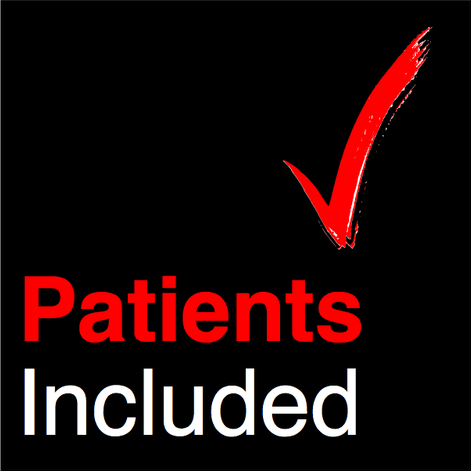“Patient centricity” is all the rage these days among pharmaceutical industry conference attendees and speakers. It is even becoming more common for actual patients to be part of the faculty/speakers and/or attendees of these conferences.
This wasn’t always the case, which is why Lucien Engelen launched the “NO-SHOW Patients Act” in 2012 (read “No-Show patients on conferences : Patients Included™“). Lucien founded and is the Director of the Reshape Center at the Radboud University Medical Center located in the Netherlands. The Center is at the “convergence of patient empowerment and (exponential) technology.”
Lucien said he no longer could imagine a conference about healthcare with a NO-SHOW approach of patients, by which he meant:
- no patient IN the program,
- no patient ON the stage or
- no patient IN the audience.
Lucien announced he would boycott such conferences by declaring “I will NO-SHOW on healthcare conferences that do not add patients TO or IN their program or invite them IN the audience also I will no longer speak at NO-SHOW conferences.”
The “Patients Included” logo shown above can be used free of copyright for conferences that have patients ON stage, IN the program or invited as patients to the conference. “Do not ask US if your are eligible for it,” says Lucien, “the audience will be your ‘judge’ ;-)” BTW, you can’t use the fact that “we are all patients” to qualify.
Now the “Patients Included” movement is getting more complicated. Some activists are developing a “Global Charter” that goes much further than Lucien’s NO-SHOW Patients Act and lays down specific compliance guidelines.
“It has been remarked on numerous occasions by many observers over a number of years that in order for the Patients Included initiative to be able to exert any sort of influence, an instrument is required against which the compliance of conference organisers may be measured, and through which they may be called to account,” said Andrew Spong, a leader of the new movement (see here). To that end, the group has developed v.0.5 of the charter, which is available for review and comment in Google Docs.
You can find the Charter on the patientsincluded.org site, but I reproduce the main clauses of the Charter below with my comments at the end:
1. CONFERENCE PLANNING
The organising committee of the conference includes patients or caregivers with experience of issues relevant to the themes of the event.
2. CONFERENCE ORGANISATION
Patients or caregivers with experience of the issues addressed by the event participate in its delivery, and appear in its physical audience.
3. CONFERENCE ATTENDANCE
The agreed travel and accommodation expenses of all patient or carer faculty participating in the advertised programme are paid in full, in advance. Scholarships* are provided by the conference organisers to allow patients or caregivers affected by the relevant issues to attend as delegates.
4. PHYSICAL ACCESSIBILITY
The disability requirements of participants are accommodated. All applicable sessions, breakouts, ancillary meetings, and other programme elements are open to patient delegates.
5. VIRTUAL ACCESSIBILITY
Access for virtual participants is facilitated, with free streaming video provided online wherever possible.
Considering specifically the type of pharmaceutical conferences I attend, it’s probably a no brainer for the organizers to comply with all these rules EXCEPT for #3, which is the most important rule of them all!
As e-Patient Dave said of his early experience with conference organizers who wanted him to speak at their events: “Like many experienced patients, back then I had plenty to say but I didn’t have any money. To attend an event and contribute value, I needed funding. I was the same person I am today – I just didn’t have any money” (see here).
I’ve been to conferences where “patient advocates” have been in the audience and participated as speakers. But they were subsidized by companies that paid the conference organizers to be on the program or to exhibit at the conference. WEGO Health, for example, has been a sponsor for several drug industry conferences and paid the way for some of their KPA’s (Key Patient Advocates) to attend and speak. Read this account: “Some Social Media Patient Opinion Leaders Want to be Paid Pharma Professionals.”
Some pharmaceutical companies may be surreptitiously paying the way for the KPAs on their payroll to attend and speak at some conferences. I suspect that was the case at a conference I attended this past January (see here).
As I have already noted, transparency is an issue that must be addressed when pharma directly or indirectly pays patient advocates to attend conferences or post on their websites (read “Patient Centricity, Transparency, & Pharma’s Reputation“).
According to the Charter notes, to comply with the scholarship clause, conference organizers must offer a minimum of two scholarships that cover registration, travel, and accommodation expenses for two patient or carer delegates in full, in advance.
There are a lot of questions about who would be eligible for scholarships and how the “winners” are selected. How will your “ordinary Joe” patient even hear about these scholarships? That is, will the process be open to all? Or will the supporting organization paying the freight game the system by actively recruiting applicants from among their paid KPAs?
In other words, scholarships must be set up to ensure that “ordinary Joe” patients with no financial ties to the pharmaceutical industry (directly or indirectly) have an equal opportunity to win as do paid KPAs. That can’t happen if the process occurs behind closed doors.









![6 Digital Tools at the Center of Healthcare Digitalization [INFOGRAPHIC]](http://ec2-54-175-84-28.compute-1.amazonaws.com/pharma-mkting.com/wp-content/uploads/2021/04/6DigitalTools_600px-100x70.jpg)




